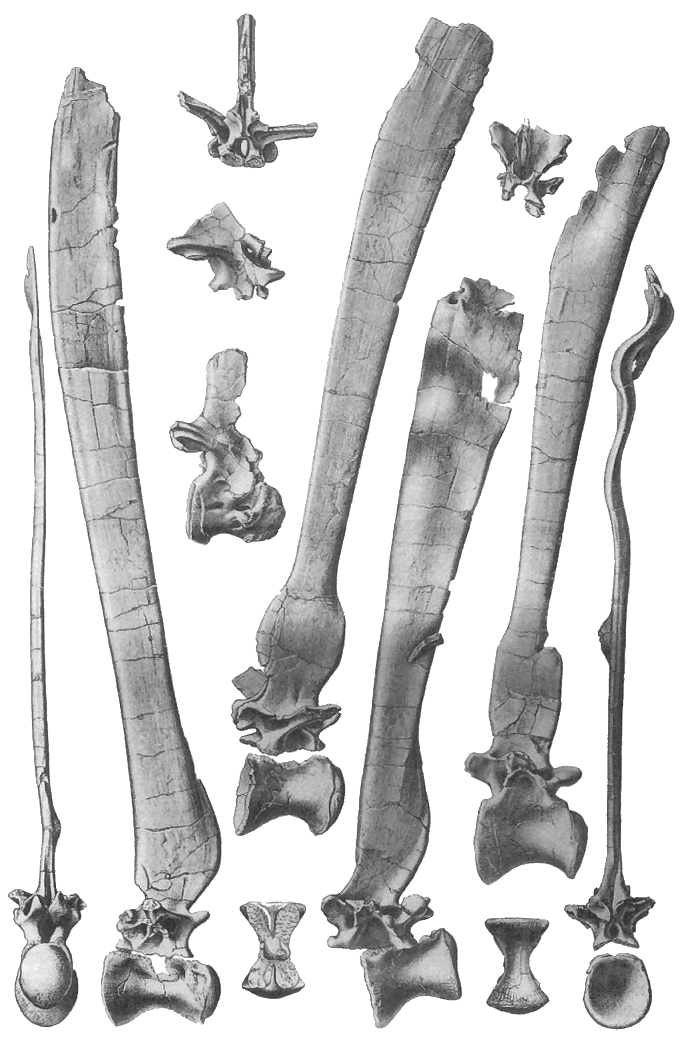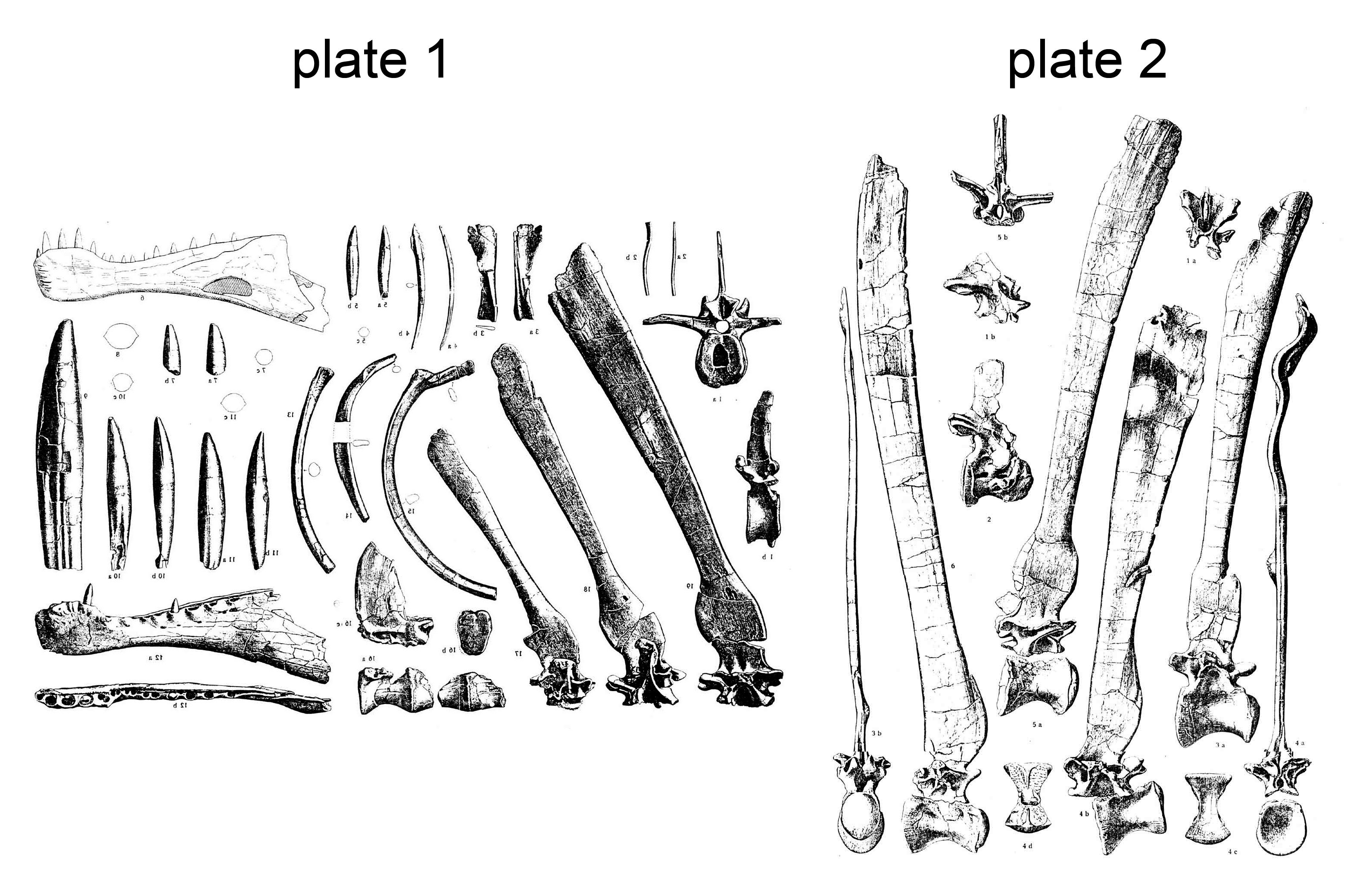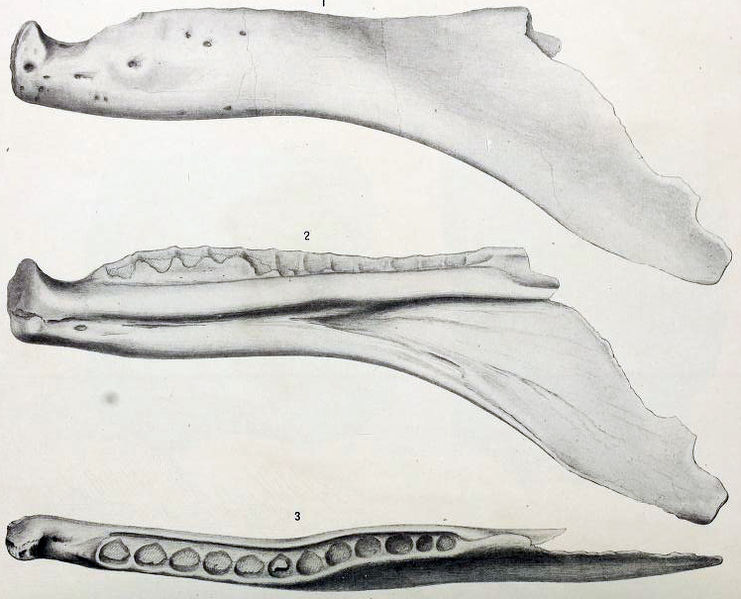|
|
Post by theropod on Oct 4, 2014 14:51:24 GMT 5
I guess there’s no description needed. This partially overlaps with what I’ve previously posted on another thread, but that one didn’t really seem appropriate for fossils.   I’ll start with the above (click the images to enlarge them) screenshots from planet dinosaur, showing the Spinosaurus neural arch that alledgedly had its spine broken off by a bite. Does anyone know whether this is described in detail anywhere? Is there any evidence of a bite wound, or is this even a real pathology or post-mortem damage? |
|
|
|
Post by creature386 on Oct 4, 2014 16:00:49 GMT 5
I have quite a lot:Lamanna MC, Sues H-D, Schachner ER, Lyson TR (2014) A New Large-Bodied Oviraptorosaurian Theropod Dinosaur from the Latest Cretaceous of Western North America. PLoS ONE 9(3): e92022. doi:10.1371/journal.pone.0092022  www.calvertmarinemuseum.com/cmmfc/newsletter/CMMFC_Newsletter_2004-04.pdf www.calvertmarinemuseum.com/cmmfc/newsletter/CMMFC_Newsletter_2004-04.pdfKallay et al. Bone Reactions on a Pliocene Cetacean Rib Indicate Short-Term Survival of Predation EventSellés, A. G. and Vila, B. Laying under stressful conditions: temporal occurrence of pathologic sauropod eggshells in the Late Cretaceous of northeastern Iberian PeninsulaFarke, Andrew, A. 2004. Horn Use in Triceratops (Dinosauria: Ceratopsidae): Testing Behavioral Hypotheses Using Scale Models. Palaeontologia Electronica 7(1):10p, 3MB; |
|
Deleted
Deleted Member
Posts: 0
|
Post by Deleted on Oct 4, 2014 16:45:00 GMT 5
I’ll start with the above (click the images to enlarge them) screenshots from planet dinosaur, showing the Spinosaurus neural arch that alledgedly had its spine broken off by a bite. Does anyone know whether this is described in detail anywhere? Is there any evidence of a bite wound, or is this even a real pathology or post-mortem damage? Sorry, no description for it yet. Here's another bitten Spinosaurus spine though, it's from the holotype this time.   Spine 4b is the one with the tooth. The interesting thing about that Morrocan spine and the bitten holotype spine is that they seem to be evidence against a full skin sail on Spinosaurus, the bites are below the striated area, and a scavenger/predator wouldn't really take bites out of skin-and-bone areas since it wouldn't be a very good place to bite due to lack of flesh and vitals(for predators) and for nutritional reasons(a low-vascularization skin sail wouldn't have much to offer in terms of nutrition due to the low amount of food). |
|
|
|
Post by theropod on Oct 4, 2014 20:04:16 GMT 5
Is that really a pathology, not just some fragment that got stuck on it as a result of taphonomic processes? That seems likely considering the spine is downright curly from deformation, including a depression at the height of that small
I’ve looked for it in the description, Stromer would certainly have noticed any pathologies that easily visible (and illustrated by himself) and indeed he notes one, but it’s on the dentary:
Translating to "On the left ramus, laterally next to the 5th alveolus there is a small pathological thickening of bone, likely the consequence of a healed injury."
Reference:
Stromer, Ernst: Ergebnisse der Forschungsreisen Prof. E. Stromers in den Wüsten Ägyptens. 11. Wirbeltier-Reste der Baharije-Stufe (unterstes Cenoman). 3. Das Original des Theropoden Spinosaurus aegyptiacus nov. gen., nov. sp.. Abhandlungen der Königlich Bayerischen Akademie der Wissenschaften, Mathematisch-physikalische Klasse, Vol. 28 (1915); 3; pp. 1-32
|
|
Deleted
Deleted Member
Posts: 0
|
Post by Deleted on Oct 4, 2014 20:37:48 GMT 5
Is that really a pathology, not just some fragment that got stuck on it as a result of taphonomic processes? That seems likely considering the spine is downward curly from deformation, including a depression at the height of that small I’ve looked for it in the description, Stromer would certainly have noticed any pathologies that easily visible (and illustrated by himself) and indeed he notes one, but it’s on the dentary: Translating to "On the left ramus, laterally next to the 5th alveolus there is a small pathological thickening of bone, likely the consequence of a healed injury."
Reference:Stromer, Ernst: Ergebnisse der Forschungsreisen Prof. E. Stromers in den Wüsten Ägyptens. 11. Wirbeltier-Reste der Baharije-Stufe (unterstes Cenoman). 3. Das Original des Theropoden Spinosaurus aegyptiacus nov. gen., nov. sp.. Abhandlungen der Königlich Bayerischen Akademie der Wissenschaften, Mathematisch-physikalische Klasse, Vol. 28 (1915); 3; pp. 1-32 The posterior/anterior view of 4b(4a) shows a swelling at the location of the tooth/fragment, a swelling which looks really similar to that of a healed tooth mark. Also, it seems that the severe bending is roughly at the location where the striae would be(the distorted part occupies around a third of the spine), while below it, the spine is pretty straight. Damage from the same attack? Possible, but we may never know. |
|
|
|
Post by theropod on Oct 4, 2014 20:58:45 GMT 5
Stromer 1915:
that is:
"A further seven vertebrae c-i are more or less damaged due to loss of some parts or deformation, particularly their diapophyses. Especially g (Plate 11, Figures A a, b, c, d) is instructive in this regard, since its neural arch is somewhat displaced caudally on the, here-undeformed centrum, in the middle of the anterior border of its Processus spinosus a part of the posterior rim of centrum i (Plate II, Figure 6) is pressed in and the dorsal part is wavily bent transversely."
There is no note of a pathology, but it seems that fragment is part of another vertebra’s centrum.
I agree that the bending is the result of taphonomy, it’s too smooth to be the result of an attack. And I think the same holds true for what you call swelling–I don’t think it is, I think it’s deformation caused by fossilising together with the overlying fragment being pressed into it.
|
|
Deleted
Deleted Member
Posts: 0
|
Post by Deleted on Oct 4, 2014 21:11:40 GMT 5
Stromer 1915: that is: "A further seven vertebrae c-i are more or less damaged due to loss of some parts or deformation, particularly their diapophyses. Especially g (Plate 11, Figures A a, b, c, d) is instructive in this regard, since its neural arch is somewhat displaced caudally on the, here-undeformed centrum, in the middle of the anterior border of its Processus spinosus a part of the posterior rim of centrum i (Plate II, Figure 6) is pressed in and the dorsal part is wavily bent transversely."There is no note of a pathology, but it seems that fragment is part of another vertebra’s centrum. I agree that the bending is the result of taphonomy, it’s too smooth to be the result of an attack. And I think the same holds true for what you call swelling–I don’t think it is, I think it’s deformation caused by fossilising together with the overlying fragment being pressed into it. Oh. Looks like interpretations of this kind of thing can be somewhat off if you don't have the source paper!  And as a non-german speaker, I wouldn't be able to really use if even if I had it.  |
|
|
|
Post by theropod on Oct 4, 2014 21:27:18 GMT 5
|
|
Derdadort
Junior Member
  Excavating rocks and watching birds
Excavating rocks and watching birds
Posts: 267 
|
Post by Derdadort on Oct 5, 2014 0:52:33 GMT 5
|
|
|
|
Post by theropod on Oct 5, 2014 1:36:32 GMT 5
That’s only the second open access article that I’ve ever seen on springer! Thanks, great find!  Now, I’m gonna post the inevitable "Labrosaurus ferox":  Somewhat related to the above, it shows extensive bone remodeling in the anterior dentary, as well as an odd shape of the posterior end, both probably attributable to traumatic loss of teeth and fractures. In the lower jaw of L. ferox there were plainly 12 teeth. The first was placed 63 mm. behind the tip of the jaw, between which and the tooth there is a deep notch. The posterior part of the dentary is bent downward in an extraordinary way, somewhat like that of a fringilline bird. These peculiarities show that this species belongs to a family entirely distinct from that typified by Allosaurus. Gilmore was the first to note that the strange shape of the dentary is likely the result of injuries: Now, a suggestion regarding the type of Labrosaurus ferox. The deep notch in the edentulous part of the dentary and the decided bending down of the pos- terior portion of the bone are features so entirely peculiar to anything known among the Theropodous dinosauria, as to suggest that this dentary is abnormal
in these respects, and that it may have been produced through injury, though, to
be sure, the bone as now preserved shows no evidence of such malformation.From here: archive.org/details/osteologyofcarni00gilmHay 1908: ia700703.us.archive.org/18/items/cbarchive_48073_oncertaingeneraandspeciesofcar1878/oncertaingeneraandspeciesofcar1878.pdf |
|
|
|
Post by theropod on Oct 6, 2014 22:41:49 GMT 5
|
|
|
|
Post by creature386 on Oct 7, 2014 17:59:12 GMT 5
|
|
|
|
Post by Godzillasaurus on Oct 12, 2014 22:41:15 GMT 5
Haven't there been descriptions of carcharodontosaurus bite marks on spinosaurus' vertebrae?
Planet Dinosaur said that as well. And it also made a few other hypothetical claims that I non-hesitantly agreed with.
|
|
|
|
Post by Godzillasaurus on Oct 12, 2014 22:42:17 GMT 5
So generally I would consider it a more valuable source than Monsters Resurrected, which has so many problems concerning spinosaurus that it is just silly (although there are factual elements that are clear as day, this does not outweigh the negatives)
|
|
|
|
Post by theropod on Oct 13, 2014 1:29:03 GMT 5
This wasn’t intended to become a place to discuss the reliability of documentaries, you already made a thread that is appropriate for the subject. I posted the Spinosaurus vertebra alledgedly bitten in my very opening post. The thing is, Planet Dinosaur made us aware of it, but I have been unable to verify it. The same also goes for that partial Spinosaurus jaw with the embedded Onchopristis barb.
I do think that these are real fossils, but I’d like to find some sort of description, or at least mention, in a scientific source.
|
|